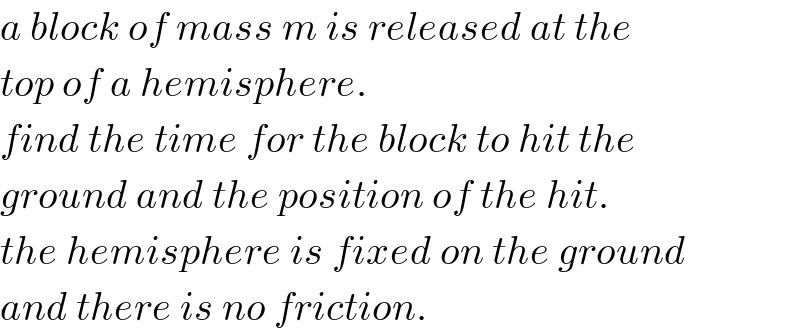
Question and Answers Forum
Question Number 73297 by mr W last updated on 10/Nov/19

Commented by mr W last updated on 10/Nov/19

Answered by ajfour last updated on 10/Nov/19
![let angle descended until in contact be θ. mgcos θ=((mv^2 )/R) ((mv^2 )/2)=mgR(1−cos θ) ⇒ mgRcos θ=2mgR(1−cos θ) ⇒ θ=cos^(−1) (2/3) v=(√((2gR)/3)) (vcos θ)t=d−Rsin θ ⇒ d=(((√5)R)/3)+((2vt)/3) .....(i) Rcos θ=(vsin θ)t+((gt^2 )/2) ⇒ ((2R)/3)=(((√5)v)/3)t+((gt^2 )/2) ⇒ 3gt^2 +2(√5)vt−4R=0 t=((−2(√5)v+(√(20v^2 +48Rg)))/(6g)) =((−2(√5)(√((2gR)/3))+(√((((40)/3)+48)Rg)))/(6g)) t =(√(R/g))×((((√(46))−(√(10))))/(3(√3))) ....(ii) Now from (i) d=(((√5)R)/3)+((2vt)/3) time for circular arc path_(−) mgsin φ=((mdv)/dt) v=(√(2gR(1−cos φ)))=2(√(gR))sin (φ/2) dv=(√(gR))cos (φ/2)dφ ⇒ ∫_0 ^( T) dt=(√(R/g))∫_0 ^( θ) ((cos (φ/2))/(2sin (φ/2)cos (φ/2)))dφ T = (√(R/g))ln ∣(1/(sin (φ/2)))−(1/(tan (φ/2)))∣_0 ^θ T =(√(R/g)){ln ((1/(sin (θ/2)))−(1/(tan (θ/2)))) −lim_(φ→0) ln (((2sin^2 (φ/4))/(2sin (φ/4)cos (φ/4))))} second term→−∞ T not defined. tan θ=((2tan (θ/2))/(1−tan^2 (θ/2))) let tan (θ/2)=z ⇒ ((√5)/2)=((2z)/(1−z^2 )) ⇒ z^2 +(4/(√5))z−1=0 ⇒ z=((−(4/(√5))+(√(((16)/5)+4)))/2) tan (θ/2)=(1/(√5)) d=(((√5)R)/3)+(2/3)(√((2gR)/3))[(√(R/g))×((((√(46))−(√(10))))/(3(√3)))] ⇒ d=(R/3){(√5)+((2(√2))/9)((√(46))−(√(10)))} =(((4(√(23))+5(√5))/(27)))R . t_(total) =T+(√(R/g)){((((√(46))−(√(10))))/(3(√3)))} T is not defined.](Q73303.png)
Commented by mr W last updated on 10/Nov/19

Answered by mr W last updated on 10/Nov/19

Commented by mr W last updated on 10/Nov/19
![at θ: (1/2)mv^2 =mgR(1−cos θ) v=(√(2gR(1−cos θ)))=2(√(gR)) sin (θ/2) v=R(dθ/dt) (dθ/dt)=2(√(g/R)) sin (θ/2) ∫_0 ^θ ((d((θ/2)))/(sin (θ/2)))=(√(g/R))∫_0 ^t_1 dt −∫_0 ^θ ((d(cos (θ/2)))/(1−cos^2 (θ/2)))=t_1 (√(g/R)) (1/2)[ln ((1−cos (θ/2))/(1+cos (θ/2)))]_0 ^θ =t_1 (√(g/R)) let F(θ)=ln ((1−cos (θ/2))/(1+cos (θ/2))) ⇒t_1 =(1/2)(√(R/g)) [F(θ)−lim_(θ→0) F(θ)] since lim_(θ→0) F(θ)=−∞, t_1 can not be determined, t_1 →+∞. at θ=ϕ: N=0 mg cos ϕ=m(v^2 /R)=2mg(1−cos ϕ) cos ϕ=2(1−cos ϕ) ⇒cos ϕ=(2/3)=2 cos^2 (ϕ/2)−1 ⇒cos (ϕ/2)=(√(5/6)), sin (ϕ/2)=(1/(√6)) ⇒sin ϕ=((√5)/3) v=(2/(√6))(√(gR)) R cos ϕ=v sin ϕ t_2 +(1/2)gt_2 ^2 0=−(4/3)+((2(√(30)))/9) ((√(g/R))t_2 )+((√(g/R))t_2 )^2 ⇒(√(g/R))t_2 =(((√(138))−(√(30)))/9) ⇒t_2 =(((√(138))−(√(30)))/9)(√(R/g)) d=R sin ϕ+v cos ϕ t_2 d=R ((√5)/3)+(2/(√6))×(2/3)×((((√(138))−(√(30)))R)/9) d=(((4(√(23))+5(√5))R)/(27))≈1.124R](Q73342.png)
Commented by ajfour last updated on 11/Nov/19

